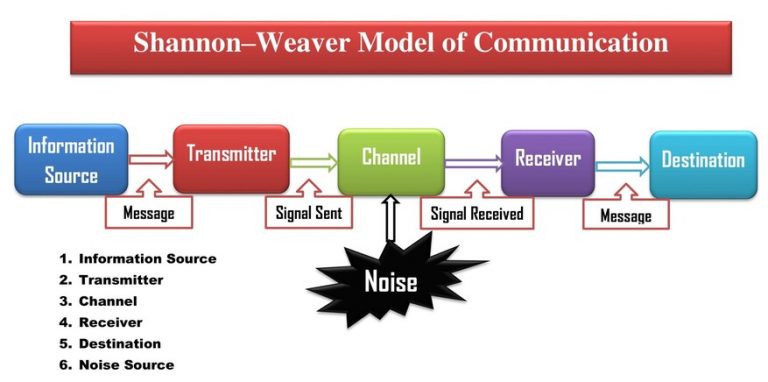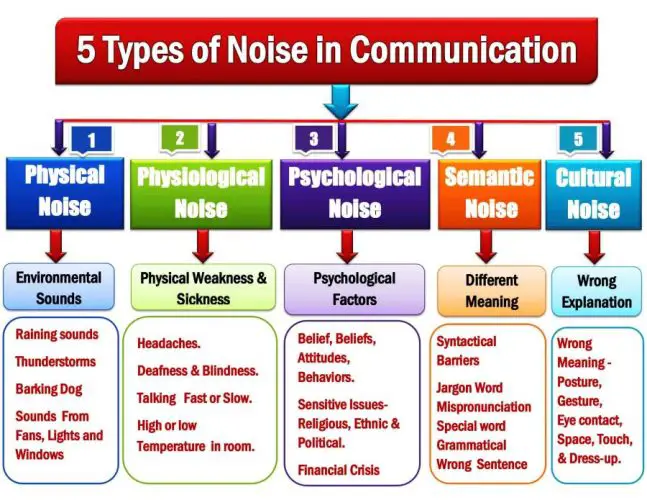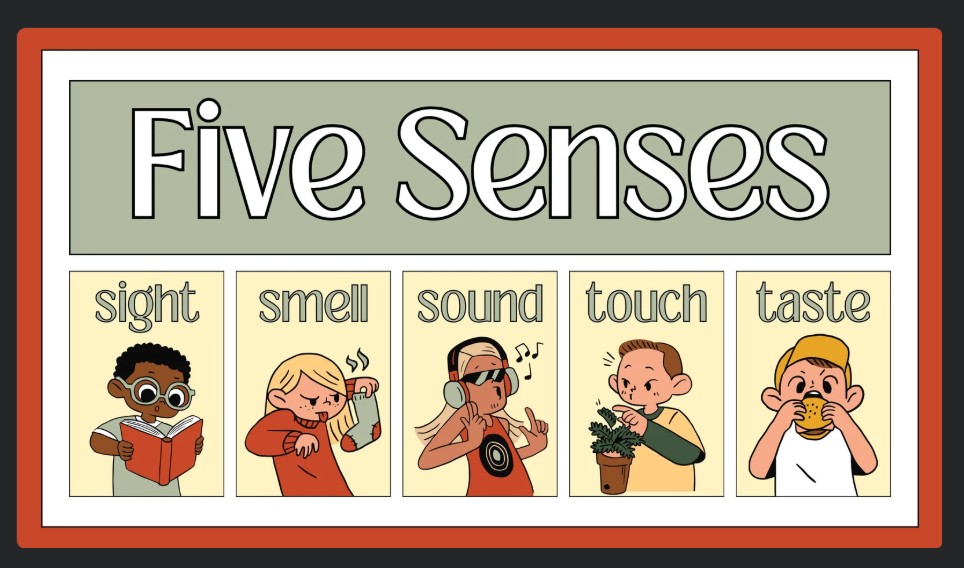This article explains Shannon and Weaver’s Model of Communication Elements and an Example of a Situation.
Shannon and Weaver’s Model of Communication
American mathematician Claude Elwood Shannon and scientist Warren Weaver introduced a linear communication model in 1949 in the article THE MATHEMATICAL THEORY OF COMMUNICATION. Therefore, it is called Shannon and Weaver’s communication model. Initially, they proposed this mathematical model to describe the signal-transmitting system and enhance telephone communication by minimizing noise. Now it is applied in every field of information and communication broadly. However, they did not present the “Feedback”; thus, the Shannon and Weaver model is an example of a linear communication model. Initially, the Shannon-Weaver model excluded feedback; hence, it is a linear communication model. Therefore, it was an incomplete communication model for not including Feedback and different types of nonverbal communication cues.
Later, Norbert Weiner included feedback on the model in countering the criticism of the one-way communication approach. Shannon and Weaver’s communication model is called the “Mother of all Communication Models” for its extreme popularity. It is also called the mathematical theory of communication, Shannon theory, and information theory in the engineering disciplines.
Shannon Weaver Model Linear or Transactional
Shannon and Weaver introduced the linear communication model with six elements: information source, transmitter, channel, receiver, destination, and noise source. The authors did not add feedback to this model in 1949; therefore, it is a linear communication model. However, later, the feedback was included by Norbert Wiener in 1950.
Feedback in the Shannon Weaver Model
In 1950, Norbert Wiener added the “Feedback” to Shannon and the Model. He presented the feedback system in the book (The Human Use of Human Beings), initially published in 1950. Norbert Wiener is also the founder of cybernetics theory, which explains the feedback system. Shannon and Weaver have not published the modified model, including feedback. Hence, the original model of Shannon and Weaver is linear, as they did not mention feedback.
Shannon-Weaver Communication Model Examples of Situation
The four Example Situations of the Shannon-Weaver Model are:
- Ordering Food Through Food Panda
- Simple Job Application Email
- Listening to the News on the Radio
- Watching the United States Presidential Debates- 2024
Shannon-Weaver Communication Model Examples of Situation-1: “Ordering Food Through Foodpanda”
- In this scenario, the customer is the sender of the information who orders a meal through the Foodpanda Mobile App (Information Source).
- The customer encodes messages and transmits them through a signal via a mobile application using TCP/IP sockets (Transmitter).
- The mobile application is the channel through which messages are transmitted from senders to receivers (Channel).
- The communication might interfere with Electrical Noise generated by the random movement of electrons in the electronic device (Noise).
- The device of food delivery is the receiver of the message. The delivery person and restaurant authority are the message’s destination who will process the food (Destination).
Shannon-Weaver Model Examples of Situation-2: “Simple Job Application Email “
- The applicants write a simple job application email with a CV attachment (Sender or Source of Information).
- The Gmail email software converts ideas into text messages to transmit them (Transmitter).
- The internet-based email conveys the message to HR professionals (Channel).
- Noise, like spam filters or internet issues, might interfere (Noise).
- The HR manager receives the email and takes further action (Receiver).
- The manager retains the email cover letter with the attached resume or forwards it to the concerned professional (Destination).
Examples of Situation of Shannon-Weaver Model-3: “Listening News on Radio”
Jon is listening to the morning news on the radio. The news presenter broadcasts news regarding today’s weather forecast. However, he cannot hear the report of the radio frequency interference (RFI). RFI is created from an internal wireless system. The news presenter is the information source, the radio is the channel, Jon is the receiver, and radio frequency interference is also known as electrical noise.
Shannon-Weaver Model Examples of Situation-4: “Watching the United States Presidential Debates- 2024″
The CNN television telecast the first general election debate for the United States Presidential Debates 2024. Donald Trump from Republican and Joe Biden from the Democratic attended the debates on June 27, 2024. Around 51.27 million people watched this presidential debate and most think that Trump performed better than Joe Biden.
These are the four example situations of the Shannon-Weaver model.
Shannon and Weaver Model of Communication Explanation
The Shannon and Weaver communication model includes six elements: Information Source, Transmitter, Channel, Receiver, Destination, and Noise Source. However, Shannon and Weaver did not mention “Feedback” in 1949; hence, it is a linear communication model like the Aristotle model and the Lasswell communication model. Many researchers and practitioners criticize this model for not adding “Feedback.” Therefore, later, Norbert Weiner included “Feedback” to describe the transactional communication process.
Many communication models have been postulated based on this model- for example, Eugene White’s model and Osgood-Schramm’s transactional model.
Shannon and Weaver Model of Communication Elements
The Six Elements of Shannon and Weaver’s Model of Communication are:
- Information Source.
- Transmitter.
- Channel.
- Receiver.
- Destination.
- Noise Source.

1. Information Source
Information source refers to the sender of the communication process that conveys the message to the receiver. It also indicates the person who generates the information and initiates the communication process.
For example, the lecturer gives a motivational speech to new students in the orientation program using a dynamic microphone. In the meantime, an airplane passes over the program. So students can not hear the lecturer’s speech for a while.
2. Transmitter
The transmitter refers to the message converter that changes the message into a signal to transfer through the communication channel. It is also called the encoding process. The messages are spoken words, written messages, pictures, music, and nonverbal cues.
For example, the lecturer’s speech is transmitted through the dynamic microphone. The microphone converts the spoken word into a signal to transfer via an electrical current on the wire.
3. Channel
A channel is the medium that conveys the message from senders to receivers. Communicators utilize distinguished channels based on communication, such as human senses, radio, television, newspapers, electronic tools, social media, and so on.
For example, the wire is the channel that conveys messages from the lecturer to students.
4. Receiver
Receivers are the people who convert the signal into a meaningful message. They are responsible for decoding the message. So, the receiver is the decoder of the communication process.
For example, students are the receivers who process the signal and sound into a meaningful message.
5. Destination
Destination indicates both senders and receivers of the communication process, who encode and decode the message.
According to Shannon and Weaver’s Model, “when I talk to you, my brain is the information source, yours the destination; my vocal system is the transmitter, and your ear and the associated eighth nerve is the receiver.”
6. Noise
Noise is the unwanted sound of the communication process that disrupts effective communication. Communicators found noise in every communication process, including verbal, nonverbal, written, visual, face-to-face, mediated, and group communication. The most common types of noise in communication are physical, physiological, psychological, semantic, electrical, syntactical, cultural noise, and so on.
For example, airplane sound is considered a physical noise in communication that distracts the students from hearing the speech.

Shannon and Weaver Communication Model Advantages and Disadvantages
Advantages of Shannon and Weaver’s Model
Shannon and Weaver Communication Model Disadvantages
1. Linear and One-Way
Firstly, it is a linear communication model due to not demonstrating Feedback. The model describes that communication is a one-way process. However, most communication processes are two-way in a directional manner. Therefore, this model is inappropriate for analyzing transactional communication processes like face-to-face discussions.
2. No Feedback
The Shannon-Weaver model does not include feedback in communication. Avoiding feedback is the major weakness of this model because every transactional communication holds feedback.
3. Focus on Technological Context
Shannon and Weaver’s model highlights the technological communication context, overlooking social, psychological, and cultural contexts. Shannon Weaver’s model was designed to explain mediated communication.
Conclusion
In short, the Six Elements of the Shannon and Weaver Model o are Information Source, Transmitter, Channel, Receiver, Destination, and Noise Source. Eventually, Norbert Weiner included the seventh element(Feedback) to make it a transactional communication model. Shannon and Weaver’s Model was introduced in 1949 and is undoubtedly a linear communication model like Aristotle, Lasswell, and David Berlo’s SMCR Model.
Established Year of the Shannon-Weaver Model?
The Shannon and Weaver model was introduced in 1949. However, there is controversy regarding the establishment year of the Shannon and Weaver model. Claude Shannon published the article(A Mathematical Theory of Communication) in the Bell System Technical Journal in 1948, known as the Shannon theory. Warren Weaver republished the previous article in 1949, adding more information and discussing the model’s implications for the effective communication process. They also renamed The Mathematical Theory of Communication while republishing it in a book. Therefore, it is known as the Shannon-Weaver model of communication.
Warren Weaver did not contribute to the article (A Mathematical Theory of Communication) published in 1948 by Claude Elwood Shannon. So, Weaver’s name cannot be included in the model published in 1948. He co-authored the same article in 1949 and renamed it “The Mathematical Theory of Communication” while reprinting it in the book. The Mathematical Theory of Communication is called Claude Shannon and Warren Weaver’s model of communication. So, it is rational to say that the Shannon and Weaver model was introduced in 1949, not 1948.
A Mathematical Theory of Communication
Shannon, 1948 Reference
| Shannon, C. E. (1948). A mathematical theory of communication. The Bell System Technical Journal, 27(3), 379-423. |
Shannon and Weaver, 1949 Reference
| Shannon, C. E., & Weaver, W. (1949). The mathematical theory of communication. The University of Illinois Press |
Citation For This Article – APA- 7th Edition:
Kobiruzzaman, M. M. (2025). Shannon and Weaver Model of Communication Explanation & Examples.Newsmoor- Best Online Learning Platform. https://newsmoor.com/shannon-and-weaver-model-of-communication-explanation-examples/

